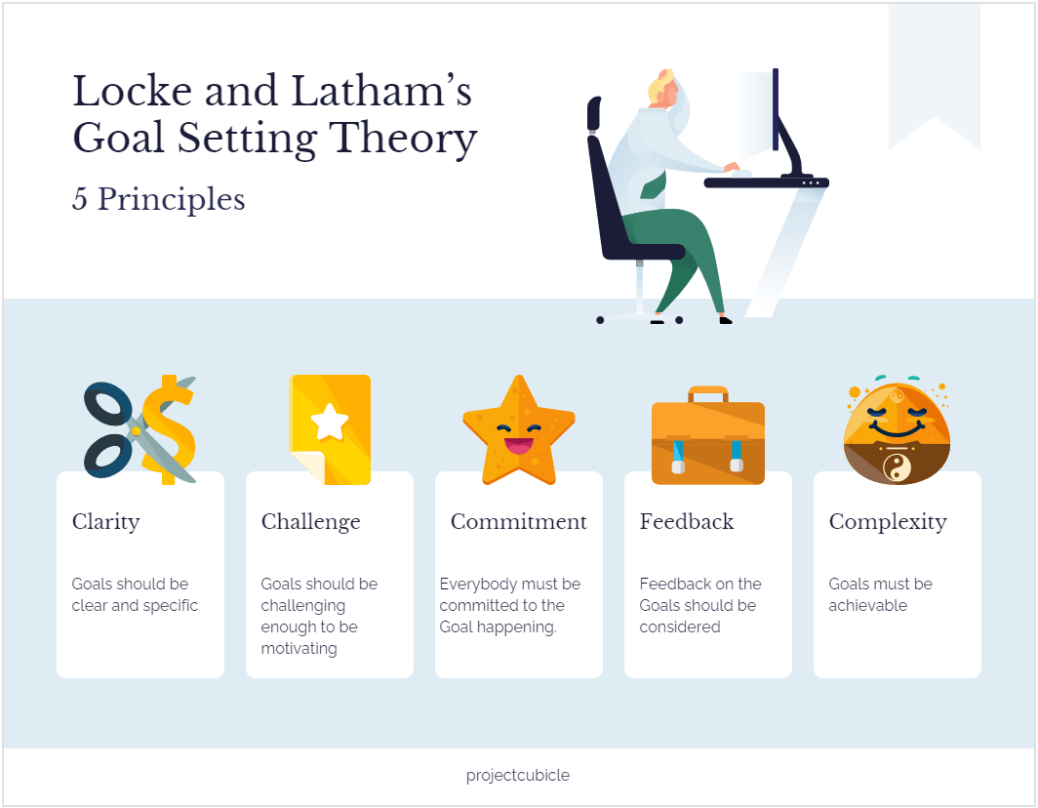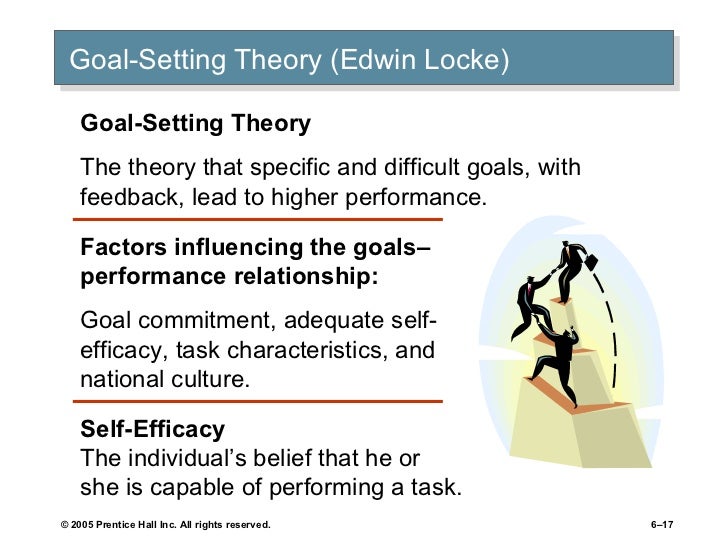
Motivation theories Locke and Latham's goal setting theory audio YouTube
Locke's Goal Setting Theory is the link between five clear principles of Goals and the performance against that Goal. Locke's work, and the subsequent research that was built on it, showed a better result for companies and employees if Goals adhered to the following five rules: Clarity. Goals must be clear and specific for all.

What is Locke's Goal Setting Theory of Motivation?
Locke's Goal Setting Theory. Locke's Goal Setting Theory is a great framework to use when setting goals for yourself or for your team. The theory is based on research showing that with the right goals your can increase both productivity and motivation. Locke and Latham were able to demonstrate that when you set specific and challenging.

Locke's GoalSetting Theory Using Goals to Advance Motivation Video
Locke, et al (1981) defined the "goal" in Goal-Setting Theory (GST) as "what an individual is trying to accomplish; it is the object or aim of an action" (p. 126). According to Moeller et al. (2012), goal setting is the process of establishing specific and effective targets for task performance. Locke, et al. (1981) also provided.

What is Locke's Goal Setting Theory of Motivation? Deepstash
Locke's 5 Principles of Goal-Setting. The foundations of Locke's goal-setting theory of motivation are the five principles—clarity, challenge, commitment, feedback, and complexity. These principles guide managers to achieve the organization's goals and improve self-efficacy and intrinsic motivation for the workforce.

Locke's GoalSetting Theory SlideBazaar
The goal-setting theory states that goals must be specific and challenging to be effective. Locke and Latham further expanded on the theory by defining 5 main principles for goal setting. 1. Clarity. Goals should be well-defined. The more detailed it is, the less likely the chance of misunderstanding.

What is Locke's Goal Setting Theory Explained in 2 min YouTube
The authors summarize 35 years of empirical research on goal-setting theory. They describe the core findings of the theory, the mechanisms by which goals operate, moderators of goal effects, the relation of goals and satisfaction, and the role of goals as mediators of incentives. The external validity and practical significance of goal-setting theory are explained, and new directions in goal.

VCE business Management Locke & Latham's Goal Setting Theory YouTube
In one study, Locke reviewed a decade's worth of laboratory and field studies on the effects of goal setting and performance. He found that, for 90 percent of the time, specific and challenging (but not too challenging) goals led to higher performance than easy, or "do your best," goals. For example, telling someone to "try hard" or "do your.

Locke and Latham’s Goal Setting Theory projectcubicle projectcubicle
In 1960's, Edwin Locke put forward the Goal-setting theory of motivation. This theory states that goal setting is essentially linked to task performance. It states that specific and challenging goals along with appropriate feedback contribute to higher and better task performance. In simple words, goals indicate and give direction to an.

Goal Setting Theory of Motivation Edwin Locke theory of Motivation
What Is Locke's Goal-Setting Theory of Motivation. November 16, 2021 by Mick. Locke's goal-setting theory explains the link between goals and motivation. And the main idea consists of two key pieces: the goal itself (specificity and complexity) and the belief in your ability to achieve it (commitment). Both feedback and rewards are also.

Edwin Locke GoalSetting Theory of Motivation YouTube
By understanding goal-setting theory, you can apply Locke and Latham's principles to your goals. Their research confirms the usefulness of SMART goal setting, and their theory continues to influence the way that we measure performance today. To use this tool, set clear, challenging goals and commit yourself to achieving them.

Locke’s Goal Setting Theory How To Set Your Business Goals
goals were measured.1 We found a positive, linear function in that the highest or most difficult goals produced the highest levels of effort and performance. Goal difficulty effect sizes (d) in meta-analyses ranged from .52 to .82

Wat is de Goal Setting Theory van Locke en Latham? agile4all
What are the key principles of goal setting theory? According to Dr. Locke and D. Latham's goal-setting theory of motivation, there are five principles: Clarity. Challenge. Commitment. Feedback.

Motivation
Locke's theory of goal setting emphasizes the transformative potential of aiming higher than the status quo. While it is important to set achievable objectives, the act of striving for something just beyond your current reach can work wonders in terms of motivation. .

VCE Business Management Locke's Goal Setting Theory YouTube
Locke's goal-setting theory of motivation, which has been tested and supported by hundreds of studies involving thousands of participants, consistently delivers positive changes in the lives of individuals worldwide (Locke and Latham, 2019). This article will address Locke's ideas and give you insight into how to benefit from them.

Goal Setting Theory of Motivation EsperanzarosDuarte
Explain goal-setting theory. In the 1960s, Edwin Locke proposed that intentions to work toward a goal are a major source of work motivation. This theory has been supported in more than one thousand studies with all types and levels of employees. To motivate, goals must have specificity, commitment, challenge, and feedback.

PPT CHAPTER 12 Work Motivation and Rewards PowerPoint Presentation
In the years following the release of Toward a Theory of Task Motivation and Incentives, Locke would go on to partner with Dr. Gary Latham.Together, the pair further explored and researched the effects of goal setting. In 1990, Locke and Latham published A Theory of Goal Setting and Task Performance.This book expanded on goal setting theory and created a framework for a more effective goal.